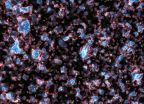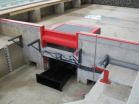(Press-News.org) New space research published this week (Thursday 21 October) in the journal Nature, has settled decades of scientific debate. Researchers from the University of California (UCLA) and British Antarctic Survey (BAS) have found the final link between electrons trapped in space and the glow of light from the upper atmosphere known as the diffuse aurora. The research will help us understand 'space weather', with benefits for the satellite, power grid and aviation industries, and how space storms affect the Earth's atmosphere from the top down.
Scientists have long understood that the 'diffuse aurora' is caused by electrons striking the upper atmosphere. However, the electrons are normally trapped much higher up in the Earth's magnetic field through a long chain of events starting with the Sun. The problem is to understand how these electrons reach the atmosphere.
Since the 1970s scientists have debated whether very low frequency (VLF) radio waves could scatter the trapped electrons into the atmosphere. Two types of VLF waves were identified in space as the possible cause of the 'diffuse aurora', but despite years of argument and research no conclusive result had been possible. The new research shows, without doubt, that VLF waves known as 'chorus' are responsible; so-called since the signals detected by ground-based recording equipment sound like the bird's dawn chorus when played back through a loud speaker.
Through detailed analysis of satellite data the authors were able to calculate the effects on the trapped electrons and identify which radio waves were causing the scattering.
Lead author Professor Richard Thorne from UCLA says,
"The breakthrough came when we realised that the electrons being lost from space to the Earth's atmosphere were leaving a signature, effectively telling a story about how they were being scattered. We could then analyse our satellite data on the two types of VLF waves and by running calculations on them – including the rate at which the electrons were being lost to the Earth's atmosphere – we could clearly see that chorus waves were the cause of the scattering."
Professor Richard Horne from British Antarctic Survey says,
"Our finding is an important one because it will help scientists to understand how the diffuse aurora leads to changes in the chemistry of the Earth's upper atmosphere, including effects on ozone at high altitude, which may affect temperature right through the atmosphere.
"We are also including the VLF waves into computer models to help predict 'space weather' which not only affects satellites and power grids, but also the accuracy of GPS navigation and high frequency radio communications with aircraft on polar routes."
The 'diffuse aurora', is not the same as the 'discrete aurora' known as the northern and southern lights. 'Discrete aurora' look like fiery moving curtains of colourful light and can be seen by the naked eye, whereas the diffuse aurora is much fainter but more extensive. The 'diffuse aurora', which typically accounts for three-quarters of the energy input into the upper atmosphere at night, varies according to the season and the 11 year solar cycle.
###
Citation:
Thorne, R. M., Ni, B., Tao, X., Horne, R. B., & Meredith N. P., Scattering by chorus waves as the dominant cause of diffuse auroral precipitation, Nature, doi:10.1038/nature09467 (2010).
*Chorus waves: Very low frequency radio waves coming from space and first detected on the ground. So-called because when played back through a loud speaker they sound like the bird's dawn chorus
*Diffuse aurora: caused when electrons that are trapped in the Earth's magnetic field are funnelled towards the polar atmosphere. Light is emitted when the electrons collide with neutral atoms in the upper atmosphere. The diffuse aurora is not generally visible to the naked eye but is well captured in satellite images.
*Discrete aurora: known as the Aurora Borealis at the North Pole (above the Arctic circle) and Aurora Australis at the South Pole (above Antarctica). They look like fiery, moving curtains of colourful light and can be seen by the naked eye whereas the diffuse aurora is much fainter but is more extensive and can cover the whole sky.
Issued by the BAS Press Office:
Heather Martin, Tel: +44 (0)1223 221414; mobile: 07740 822229; email: hert@bas.ac.uk
Linda Capper, Tel: +44 (0)1223 221448; mobile: 07714 233744; email: lmca@bas.ac.uk
Scientist contact details:
Prof Richard Horne, British Antarctic Survey (also Honorary Professor at the University of Sheffield)
Tel: +44 (0)1223 221542; Mobile: 0778 6733 667; email: rh@bas.ac.uk
Dr Nigel Meredith, British Antarctic Survey,
Tel: +44 (0)1223 221299; Mobile: 0797 0037 866; email: nmer@bas.ac.uk
Prof Richard Thorne, University of California Los Angeles,
Tel: +001 310 8255974; Mobile: 310 6146630; email: rmt@atmos.ucla.edu
Dr Binbin Ni, University of California Los Angeles,
Tel: +001 310 8251659; Mobile: 310 4029724; email: bbni@atmos.ucla.edu
Dr Xin Tao, University of California Los Angeles,
Tel: +001 310 8251659; Mobile: 832 2096127; email: xtao@atmos.ucla.edu
For stunning broadcast-quality footage and stills of Antarctica, plus a copy of the full Nature paper – Scattering by chorus waves as the dominant cause of diffuse auroral precipitation:
ftp://ftp.nerc-bas.ac.uk/pub/photo/Nature-diffuse-aurora/
Images used should be credited to British Antarctic Survey or NASA – please see caption guidelines in the word document found on the above ftp site
Notes for editors:
British Antarctic Survey (BAS), a component of the Natural Environment Research Council, delivers world-leading interdisciplinary research in the Polar Regions. Its skilled science and support staff based in Cambridge, Antarctica and the Arctic, work together to deliver research that underpins a productive economy and contributes to a sustainable world. Its numerous national and international collaborations, leadership role in Antarctic affairs and excellent infrastructure help ensure that the UK maintains a world leading position. BAS has over 450 staff and operates five research stations, two Royal Research Ships and five aircraft in and around Antarctica.
END
A European team of astronomers using ESO's Very Large Telescope (VLT) has measured the distance to the most remote galaxy so far. By carefully analysing the very faint glow of the galaxy they have found that they are seeing it when the Universe was only about 600 million years old (a redshift of 8.6). These are the first confirmed observations of a galaxy whose light is clearing the opaque hydrogen fog that filled the cosmos at this early time. The results will be presented at an online press conference with the scientists on 19 October 2010, and will appear in the 21 October ...
HOUSTON - Long overshadowed by p53, its famous tumor-suppressing sibling, the p63 gene does the tougher, important job of stifling the spread of cancer to other organs, researchers at The University of Texas MD Anderson Cancer Center report in the Oct. 21 issue of Nature.
Not only does a specific form of p63 protein block metastasis, but it does so by activating the enzyme Dicer, which plays a pivotal role in the creation of micro RNAs, tiny bits of RNA that regulate a host of cellular processes.
"p63 is a master regulator of metastasis, an important role in its own ...
Researchers from Mount Sinai School of Medicine, in collaboration with investigators of the National Institute of Health and Medical Research (INSERM) of France led by Nicolae Ghinea, PhD, have found a common link among several malignant tumor types in all grades of cancer. This breakthrough may ultimately provide a new diagnostic or therapeutic target to detect cancer early or stop tumor growth. The study is published in the October 21 issue of The New England Journal of Medicine.
The team discovered that a hormone receptor typically found in human reproductive organs ...
COLUMBUS, Ohio – A new study led by Ohio State University cancer researchers describes a novel cancer-specific protein that is present in a broad range of cancer types and at all stages of tumor development, from premalignant cells to metastatic tumor cells.
If verified, the antigen could serve as a marker for the early detection and treatment of primary and metastatic tumors, and provide a target for the development of anticancer therapies, the researchers say.
In addition, a vaccine designed to target these cancer-cell proteins, called Piwil2-like (PL2L) proteins, ...
Groundbreaking research into fingerprint detection developed at the University of Leicester now has an industrial application, thanks to a new invention by the scientist who developed the technique.
Dr John Bond's method of identifying fingerprints on brass bullet-casings, even after they have been wiped clean, was based on the minuscule amounts of corrosion which can be caused by sweat. First announced in 2008, this breakthrough was cited as one of the technologies 'most likely to change the world' by a panel of experts for BBC Focus magazine and was included in Time ...
A research team from Nanyang Technological University (NTU) has successfully designed the world's smallest on-chip low-pass filter which is 1,000 times smaller than existing off-chip filters.
A low-pass filter is a circuit that allows low-frequency signals to pass through while reducing unwanted high-frequency signals from passing through. Compared to existing off-chip filters, which are discrete and bulky components, on-chip filters occupy a small area on integrated circuit chips, which can be found in portable devices such as mobile phones, laptops, vehicle-mounted ...
Sea levels around the Falkland Islands in the South Atlantic have risen since the mid nineteenth century and the rate of sea-level rise has accelerated over recent decades, according to newly published research. The findings are as expected under global warming and consistent with observations elsewhere around the globe.
"We have been fortunate in being able to compare modern sea-level measurements obtained from tide gauges and from satellite radar altimeters with historical measurements made at Port Louis in the Falkland Islands in 1842," explained researcher Prof. Philip ...
BOSTON (October 20, 2010) - People who consume several servings of whole grains per day while limiting daily intake of refined grains appear to have less of a type of fat tissue thought to play a key role in triggering cardiovascular disease and type 2 diabetes, a new study suggests. Researchers at the Jean Mayer USDA Human Nutrition Researcher Center on Aging (USDA HNRCA) at Tufts University observed lower volumes of visceral adipose tissue (VAT) in people who chose to eat mostly whole grains instead of refined grains.
"VAT volume was approximately 10 % lower in adults ...
The follicle stimulating hormone, FSH, targets the human reproductive organs: the ovaries and testicles. In women, it stimulates maturation of ovarian follicles and production of oestrogens (via its action on granulosa cells). In men, it stimulates production of spermatozoa (via its action on the Sertoli cells).
FSH receptor, which was the subject of the work carried out by the Inserm researchers, is normally only found in cells stimulated by FSH (granulosa cells in women and Sertoli cells in men). However, it is also present in very small quantities in the blood vessels ...
Hydroelectric power is the oldest and the "greenest" source of renewable energy. In Germany, the potential would appear to be completely exploited, while large-scale projects in developing countries are eliciting strong criticism due to their major impact on the environment. Researchers at Technische Universitaet Muenchen (TUM) have developed a small-scale hydroelectric power plant that solves a number of problems at the same time: The construction is so simple, and thereby cost-efficient, that the power generation system is capable of operating profitably in connection ...



